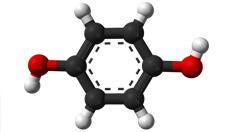







Hydroquinone molecule
Introduction
Hydroquinone, also benzene-1,4-diol or quinol, is a phenolic aromatic organic compound, with the chemical formula C6H4(OH)2. Its chemical structure has two hydroxyl groups bonded to a benzene ring in a para position. It is a white granular solid. It occurs naturally in many plants as well as in wheat, coffee, tea, beer, wine, berries but is detoxified within the liver into inert compounds.
Hydroquinone is considered one of the most effective inhibitors of melanogenesis in vitro and in vivo and is the most frequently used topical lightening agent for the treatment of various hyperpigmentary disorders. It is considered the golden standard for treatment of hyperpigmentation, with over 50 years of efficacy and safety data.
Mechanism of action
It is a phenolic compound that blocks the conversion of dihydroxyphenylalanine (DOPA) to melanin by inhibiting tyrosinase. The structural similarity between HQ and melanogenic precursors enables HQ’s interaction with tyrosinase. This interaction mediates HQ’s inhibition of tyrosinase by covalently binding to histidines or interacting with copper at the active site of the enzyme.
Additionally, HQ induced generation of reactive oxygen species and quinones leads to the oxidative damage of membrane lipids and proteins such as tyrosinase. Hydroquinone is also thought to inhibit pigmentation by depleting glutathione, modifying melanosome functions or by inhibiting DNA and RNA synthesis with selective cytotoxicity toward melanocytes and melanocyte destruction.
The cytotoxic effects of hydroquinone are not limited to melanocytes, but the dose required to inhibit cellular metabolism is much higher for nonmelanotic cells than for melanocytes. Thus, hydroquinone can be considered a potent melanocyte cytotoxic agent with relatively high melanocyte-specific cytotoxicity.
Evidence of improvement with hydroquinone (monotherapy) is usually observed at 4-6 weeks, with improvement appearing to plateau at approximately 4 months. Concentrations as high as 10% can be compounded extemporaneously for refractory cases.
Formulations
Hydroquinone is available in concentrations ranging from 2 to 5%. Higher concentrations although more effective, cause more irritation. It is readily available over the counter in some countries in various cosmetic preparations of up to 2% concentrations.
Although hydroquinone monotherapy can be effective in skin whitening treatments traditional hydroquinone formulations contain other constituents that promote a synergistic effect to increase efficacy. A popular formulation is comprised of hydroquinone and a corticosteroid to reduce inflammation, along with tretinoin, shown to reduce the atrophy associated with the corticosteroid and remove pigmentation by increasing keratinocyte turnover and the penetration of hydroquinone.
Two known inhibitors of glutathione, cystamine and buthionine sulfoximine, have also been reported useful for their enhancement of the inhibitory effect of hydroquinone on pigmentation.
Cook-Bolden et al26 conducted a 12-week, open-label study of microencapsulated HQ 4% and retinol 0.15% with antioxidants in the treatment of 21 patients (81% Fitzpatrick skin types IV–VI) with PIH (n=17) and melasma (n=4). There were significant decreases in lesion size, pigmentation, and disease severity from Week 4 to the study endpoint (all P<0.032), and reflectance spectrophotometric analysis showed statistically significant reductions in melanin content as early as Week 4 as well. A similar study with a majority of skin-of-color patients treated with microentrapped HQ 4%/retinol 0.15% and sunscreen also found this agent to be safe and effective for both PIH and melasma.
Hydroquinone adverse effects
Recently, there has been some controversy surrounding the role of hydroquinone in hyperpigmentation. Despite the remarkable overall safety of hydroquinone, hydroquinone has potential adverse effects.
Adverse events reported with HQ use include erythema, permanent leukoderma, skin irritation, contact dermatitis, cataract, pigmented colloid millium, nail pigmentation or discoloration, loss of skin elasticity, impaired wound healing, hypopigmentation of the surrounding normal skin that has been treated with HQ (“halo effect”) and post-inflammatory hyperpigmentation.
An uncommon but serious adverse effect of HQ is exogenous ochronosis. This disorder is characterized by progressive darkening in the treatment area exposed to hydroquinone. In exogenous ochronosis homogentisic acid accumulates within the dermis causing degeneration of collagen and elastic fibers occurs, followed by the appearance of characteristic ochronotic deposits consisting of crescent-shaped, ochre-colored fibers in the dermis on the malar areas, temples, inferior cheeks, and neck. It can be extremely difficult to reverse to any degree. Exogenous ochronosis is typically associated with frequent use of very high concentrations of HQ on a long-term basis although it can still occur with short-term use of 1 to 2% HQ.
Safety Reviews
Kooyers et al. pleaded for the use of hydroquinone as a skin lightening agent to be stopped completely, citing that risk of long-term effects (cancer) may no longer be ignored.
On the other hand, Nordlund et. al. reviewed the evidence for the safety of hydroquinone in the treatment of hyperpigmentation and concluded that data so far suggest that it is reasonable to use hydroquinone for treating hyperpigmentation. This is in agreement with Kamau et al. that reported that hydroquinone is generally considered very safe.
Law
Hydroquinone has been used for over 50 years and no cases of skin cancer or internal malignancy related to its topical use has been reported. of hydroquinone has been banned in Europe but not prescription use. Due to the risks of side effects such as exogenous ochronosis and permanent depigmentation following long term use, cosmetic or over-the counter use hydroquinone has been banned by the European Committee (24th Dir 2000/6/EC) and formulations have been available only through prescription.
FDA has recently expressed the same likelihood for hydroquinone in the United States. In 2006, the United States Food and Drug Administration (FDA) released a statement proposing a ban on all OTC HQ agents based on rodent studies, which suggested that oral HQ may be a carcinogen. To date, a final ruling by the FDA is still pending.
>
>
>
>
>
>
>
>
>
>
>
>
>
>
>
>
>
>
>
>
>
>
>
>
>
>
>
>
>
>
>
>
>
>
>
>
>
>
>
>
>
>
>
>
>
>
>
>
>
>
>
TOP 20
Hydroquinone
Monobenzyl Ether of Hydroquinone
Azelaic Acid
Kojic Acid
Arbutin
Retinoids
Mequinol
Niacinamide
Soy
Vitamin C
Corticosteroids
Licorice
Hydroxystilbene
Aloesin
Glutathione
Glycolic Acid
N Acetyl Glucosamine
Gentisic Acid
Green Tea
Melatonin
SKIN WHITENING AGENTS A-Z
a-Hydroxyacids
Aloesin
Alpha Tocopherol and Alpha Tocopherol Ferulate
Arbutin
Azelaic Acid
Centaureidin and Methylophiopogonanone B
Gallic Acid and Derivatives
Gingko
Ginseng
Glutathione
Glycolic Acid
Green Tea
Hesperidin
Hydroquinone
Hydroxycinnamic Acid and Derivatives
Hydroxystilbene
Kojic Acid
Licorice
Linoleic Acid
Magnesium Ascorbyl Phosphate
Melatonin
Mequinol
Monobenzyl Ether of Hydroquinone
Mulberry
N Acetyl Glucosamine
N-Acetyl-4-S-Cysteminylphenol
Niacinamide
Retinoids
Salicylic Acid
Soy
Vitamin C

<< Previous: Hesperidin
Next: Hydroxycinnamic Acid and Derivatives >>